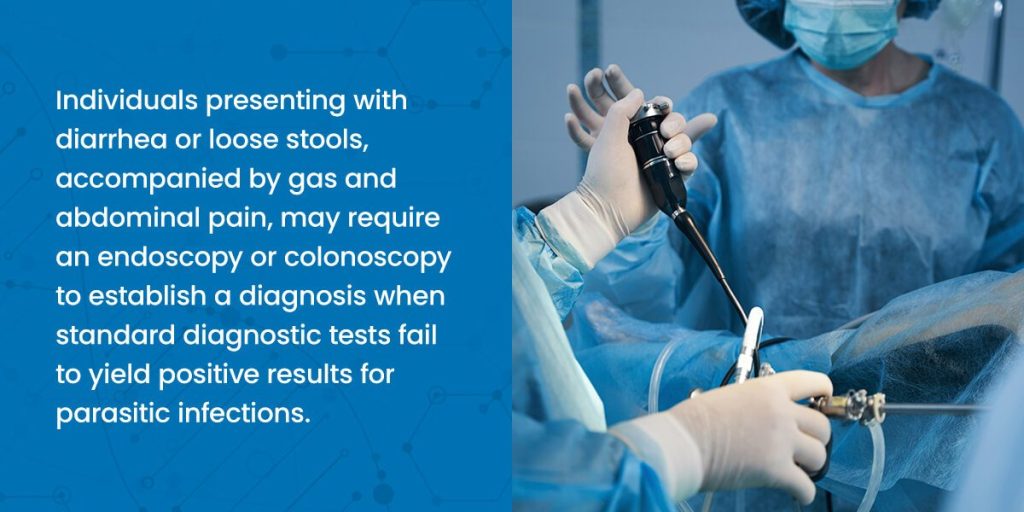Gastrointestinal parasites can result in human diseases that may be difficult to diagnose without appropriate diagnostic methods. Detecting and confirming these infections is essential for mitigating transmission and improving public health outcomes.
Common Gastrointestinal Parasites
Many gastrointestinal parasites can infect humans. While some are more common in specific areas of the world, others are widespread. Intestinal parasites have a 30 to 60% prevalence rate in developing nations with tropical and subtropical climates but can also occur elsewhere.
Common gastrointestinal parasites in humans include:
- Roundworms: Nematodes, also known as roundworms, are a large group of parasites that frequently infect animals, although some species specifically target humans as their host. Many roundworms enter the human body through oral ingestion, which can occur when individuals touch contaminated soil or feces and fail to maintain proper hand hygiene. Certain roundworms can be present in various food sources, posing a risk for infection.
- Pinworms: E. vermicularis, a specific type of roundworm, is the most common parasitic infection in the United States, with humans being its exclusive host. Also known as seatworms or threadworms, infection occurs when an individual inadvertently ingests the eggs through hand-to-mouth transmission or comes into contact with contaminated surfaces. The eggs are typically located on perianal folds, and adult female pinworms can range from 8 to 13 mm in length.
Hookworm: Hookworm encompasses several species, with A. duodenale and N. americanus being two that exclusively infect humans. These parasites can penetrate a human host through pores, hair follicles, and skin. Both species thrive in moist
- environments with inadequate sanitation and hygiene, where they feed on microorganisms present in the soil.
- Tapeworms: Tapeworms derive their name from their flattened, ribbon-like appearance, resembling a measuring tape. These parasites can achieve considerable lengths, ranging from 4 to 28 inches, with segments often detaching and passing through the intestines. Tapeworm eggs are frequently present in undercooked meats such as beef, pork, and fish.
- Liver flukes: Liver flukes, commonly found in freshwater fish, can infect humans who consume undercooked or contaminated fish. Upon entering the human body, these parasitic organisms can lead to hepatic and biliary tract disorders.
- Giardia: G. lamblia, often called giardia, is among the most prevalent parasitic infections globally. The parasite spreads via fecal-oral transmission and can be waterborne, demonstrating resistance to the chlorine concentrations typically found in tap water. Although foodborne transmission is possible, it is relatively rare. Regions with dense populations and inadequate sanitation practices are more likely to experience higher incidences of giardia infection.
- Entamoeba histolytica: E. histolytica [DPHAB1] is primarily transmitted through the fecal-oral route and is frequently associated with poor hygiene during food preparation. Infections can also occur when human waste is utilized as fertilizer. Many E. histolytica infections remain asymptomatic, but approximately 10 to 20% of infected people develop symptoms.
Symptoms of GI Parasites in Humans
Intestinal parasites can present with various symptoms in humans. The severity and nature of these clinical presentations often depend on the specific parasite responsible for the infection and the host’s immune status. The most frequently observed clinical features of parasitic infections include:
- Abdominal cramps: Upon entering the human body, parasites often reside in organs such as the liver or small intestines. Certain parasites, like hookworms, attach themselves to the intestinal wall while using the human body as a host. These disturbances in the organs can result in generalized abdominal pain.
- Diarrhea: In infections where the parasite is attached to the intestinal wall, the disruption can lead to malabsorption and the accumulation of water and electrolytes in the intestine, making it difficult for the body to form and pass solid stool.
- Gas and bloating: Parasitic infections can trigger inflammation within the intestines, resulting in an accumulation of digestive gases. The intestines may struggle to expel this excess gas, leading to distension or a sensation of bloating in the abdomen.
- Nausea or vomiting: Intestinal inflammation caused by parasitic infections can result in intestinal strictures or narrowing. This narrowing can impede proper digestion, causing feelings of nausea in infected individuals. In some cases, it can also lead to vomiting.
- Weight loss: Persistent abdominal discomfort and reduced nutrient absorption may contribute to weight loss over time. Unintentional weight loss with minimal dietary changes may serve as an indication of an intestinal parasite.
In certain instances, parasitic infections may remain asymptomatic, with infected individuals excreting the parasite through their stool without experiencing any noticeable symptoms. In contrast, more severe infections can result in complications such as intestinal obstruction, inflamed bile ducts, and anemia.
Testing for Gastrointestinal Parasites in Humans
Due to the overlapping clinical features shared by parasitic infections and other gastrointestinal illnesses, accurate and reliable diagnostic techniques are necessary to differentiate between various etiologies and establish the presence of parasitic infections.
Endoscopy or Colonoscopy

Medical professionals may use an endoscopy or colonoscopy to identify parasites. Individuals presenting with diarrhea or loose stools, accompanied by gas and abdominal pain, may require an endoscopy or colonoscopy to establish a diagnosis when standard diagnostic tests fail to yield positive results for parasitic infections. During an endoscopy, a tube is inserted through the mouth to examine the digestive tract in detail. Similarly, a colonoscopy utilizes a tube inserted into the rectum to visualize the colon and rectum.
By obtaining a comprehensive view of the digestive tract, medical professionals can identify organisms in the intestines that correspond to the patient’s symptoms and arrive at an accurate diagnosis.
Blood Test
While some parasitic infections can be identified through blood tests, many parasites cannot be detected using this diagnostic approach. There are two main types of blood tests utilized in the diagnosis of parasitic infections:
- Blood smear: Certain parasitic diseases, such as malaria, are detectable in blood samples when examined under a microscope. This method is not commonly used, but it can be beneficial in diagnosing particular parasites.
- Serology: In this diagnostic approach, medical professionals search for antibodies in the blood that are produced when the body responds to a parasitic infection.
X-Ray and Other Scans
Medical professionals may employ imaging techniques such as X-rays and magnetic resonance imaging (MRI) to identify organ lesions. Certain types of parasites can cause these lesions when they attach themselves to the lining of organs.
Stool Exams
The most common diagnostic test for parasitic infections is a stool examination, also known as an ova and parasite (O&P) test. Stool examinations identify parasites in stool by collecting multiple samples over several days and searching for parasite eggs within them.
In recent decades, molecular testing for parasites has become a powerful tool for diagnosing and understanding various gastrointestinal illnesses.
Identify Gastrointestinal Targets With Applied BioCode Inc.

The BioCode® Gastrointestinal Pathogen Panel can simultaneously identify the 17 most common targets that cause gastrointestinal illnesses. This panel can detect bacteria, viruses, and parasites, including E. histolytica, giardia, and Cryptosporidium.
With high throughput capabilities, this panel and the BioCode® MDx-3000 can deliver 188 patient samples in a single 8-hour shift. The BioCode® Gastrointestinal Pathogen Panel is US FDA 510(k) cleared and CE marked in Europe.
Get in touch with us today to learn more about our products and technology.


